By Philip Cauchi
Question - What are some good 9v9 formations?
Here is a breakdown of some 9v9 formations and their pro's and con's. Hope it helps.
1-3-3-2 system of play.
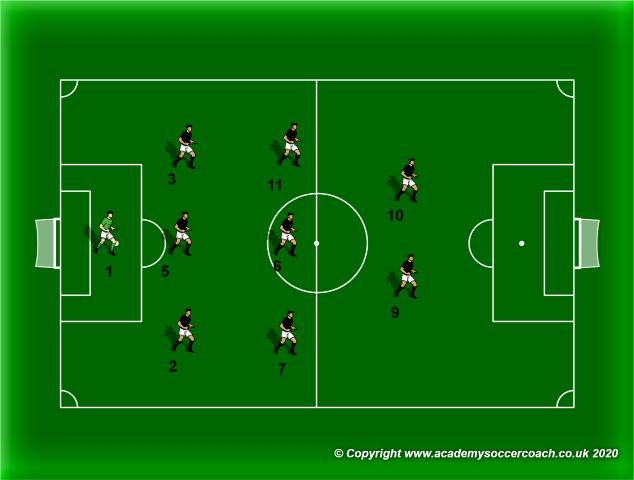
Progression to the 11v11 game: 1-4-4-2 by adding a player in both the defensive and midfield lines. 1-3-5-2 by adding the two wing backs to the midfield sector.
Pros:
Well balanced system especially during the defensive phase.
Covers the back line very well with three defenders at the back.
The two strikers can make play predictable easier during pressing actions by covering each other and forcing the opponents to play into particular areas of the pitch.
Two strikers who operate close to each other creating plenty of possible combinations in central areas in attack.
Offers plenty of passing options in the build-up.
Cons:
Could be easily outnumbered in midfield with only one central midfielder. This will need the two outside midfielders to tuck inside and provide support. As a consequence this will reduce the coverage of our width.
If the opponents play with two central midfielders the supply to our strikers might be cut off as we will be outnumbered in this sector of the field.
The central defender can also be outnumbered against formations playing with two forwards operating close to each other.
The required players’ characteristics.
The defensive line:
The two central defenders should be good at 1v1 defending. They should also understand the principles of defending very well. One of the two defenders should be at least a ball playing defender to aid in the build-up phase. Dominating aerial play should be a major prerequisite for the central defenders.
The midfield line:
The central midfielder should possess a high level of technique to aid in the construction of attacks and distribution of passes. This player should also be good at winning the ball in 1v1 duels. The lateral midfielders should be able to recognise the moment of when to move forward to provide width and further options in attack. These two players should also be able to apply pressure on the ball and provide balance in midfield in the non-possession phase.
The forward line:
The two strikers should work at staggered angles with each other to create more playing options up front. At least one of the two strikers should be fast and good in the 1v1 attacking phase. The other striker should be able to receive the ball with his back to the goal and lay off the ball under pressure. Both strikers should be able to finish well under pressure.
Characteristics of the 1-3-3-2 system of play.
Can be effectively used when a team possesses highly technical midfield players who are confident in circulating the ball well. This requires a style of play in which teams aim to dominate possession by playing short and quick passes. The players must be confident in rotating and playing in different positions (mobility) in order to support the attack and create overloads.
1-3-2-3 system of play.
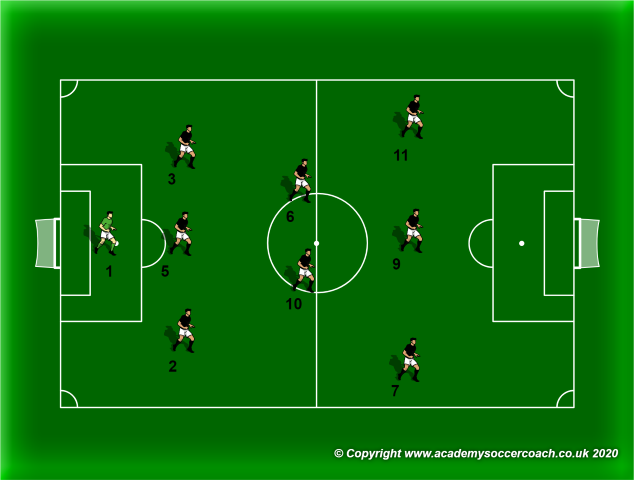
Progression to the 11v11 game: 1-3-4-3 by adding the two wing backs to the midfield sector or a 1-4-3-3 by adding a central defender and a central midfielder.
Pros:
Offers a lot of options to circulate the ball to keep possession.
Has a good balance both in possession and out of possession.
Is strong in attack with lots of penetrating options. The three men forward line can stretch the opposition’s defence whilst creating seams in the opposition’s defence and opportunities for 1v1s.
The central midfield is well covered with the two central midfielders protecting the back line.
Has width in the back line.
With a front three it is easier to apply immediate pressure on the ball if possession is lost in the attacking third.
Cons:
If the wingers are positioned too wide, the striker will be isolated with reduced options to attack from central areas. On the other hand if the wingers move too much towards the inside width will be lost.
If the wingers do not track back during the phase of non-possession, space will open up on the flanks where the outside defender (full back) will be outnumbered.
The two central midfielders might get easily outnumbered against systems playing with three players in midfield.
The required players’ characteristics.
The defensive line:
The defenders should all be proficient in the 1v1 defending. They should understand well who, when and how to apply pressure on the ball and to cover each other well with the correct angles and distances. At least one of the central defenders must be able to play the ball out of the back with confidence.
The midfield line:
The midfielders should be able to form angles at the correct distances to encourage more circulation of the ball. They should understand how and when to remain compact to prevent the opponents from achieving penetration in the non-possession phase. A good combination will be to have an offensive midfielder and the other who is more defensive.
The forward line:
The wing players should be good at taking on defenders in 1v1 duels. The striker should be able to offer length and hold the ball well to combine with either a winger or a midfielder inserting into attack. The striker should have a positive attitude towards finishing under defensive pressure.
Characteristics of the 1-3-2-3 system of play.
The structure of this system by nature offers many triangles and angles between players. Therefore this system of play can be effectively used with teams who have technically proficient players and who can build well-structured attacks from the back. The two central midfielders play a major role in this system. These two players must be great at creating passing options and play precise line breaking passes.
1-2-4-2 system of play.
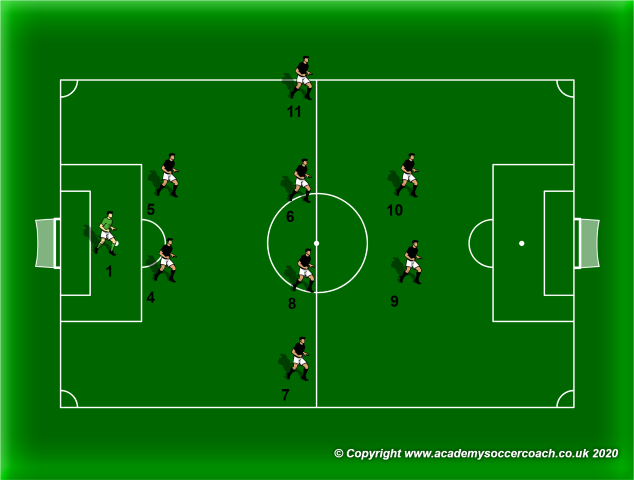
Progression to the 11v11 game: 1-4-4-2 by adding the two full backs to the defensive line.
Pros:
Very compact and solid in the middle vertical sector.
It is strong in midfield with plenty of options during the build-up phase.
The two strikers operating close to each other provide various options in central areas in the attacking third.
Cons:
There is lack of width in attack with no wingers. The need for the lateral midfielders to push forward to aid the momentum of an attack is imperative.
With only two central defenders in the back line there is lack of defensive coverage.
The required players’ characteristics.
The defensive line:
The two central defenders should be good at 1v1 defending and at least one of them should be comfortable on the ball to aid in the attack construction during the build-up phase. These two players should also dominate aerial duels.
The midfield line:
One the central midfielders should be a playmaker while the other more of a ball winner who is good at 1v1 defending. The two lateral midfielders should be able to track back when needed to form a line of four at the back, covering the whole width of the pitch when the opponents are attacking. During the phase of possession the two lateral midfielders should provide both width and length with the aim of stretching the opposition’s defence.
The forward line:
The two strikers should operate at staggered angles with each other. One of them provides length while the other operates between the lines in search of pulling defenders out of position to unbalance the opposition’s defensive structure and create space. Between them the two strikers should be proficient in heading skills, be able to take on defenders in 1v1 situations, and confident to finish at goal with accuracy.
Characteristics of the 1-2-4-2 system of play.
It is evident that in this system of play the strengths lie in the middle where there is the majority of numbers. This makes it easier to build-up in central areas, provided that the team has the right players who can create and exploit space. The lateral midfielders are used to create width and possibilities to switch the point of attack whenever penetration cannot be achieved. Penetration could be achieved by either playing crosses or through direct vertical play. The presence of two strikers in attack makes both options easier to achieve provided that adequate support from midfield exists.
1-2-3-2-1 system of play.
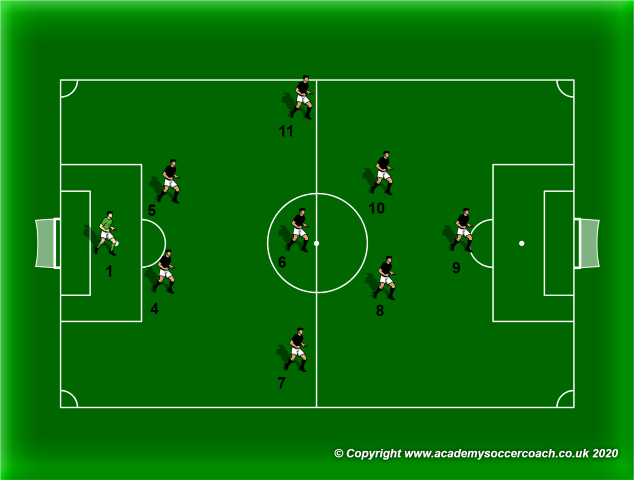
Progression to the 11v11 game: 1-4-3-2-1 by adding the two full backs to the defensive line.
Pros:
In the midfield sector we have many angles and support to circulate the ball with the ability of playing vertical passes or switch the point of attack. This is due to the width established in the midfield third of the field and the three players in central midfield.
During the non-possession phase the middle sector is compact with three central midfielders, and with attacking midfielders (8 and 10) dropping to operate close to the central defensive midfielder (6).
A very solid central block with players covering each other in different lines.
It is easier to track and mark players dropping between the lines with the use of the central defensive midfielder (6).
Cons:
The striker will be isolated if not aided by the two attacking midfielders.
Space is left behind the two lateral midfielders (7 and 11) which makes it harder to defend especially when playing against three forwards. To counter this we would need the lateral midfielders to drop back and form a back line of four players to cover the whole width.
A high physical load is put on the lateral midfielders who must cover the whole of their respective flank, aiding the attack and recovering back into position in the negative transition.
The required players’ characteristics.
The defensive line:
The two central defenders should be good in the 1v1 defending while at least one of them be comfortable on the ball during the build-up phase. These two players should also be proficient in aerial duels and in the principles of defending and zonal marking while identifying how and when to remain compact to delay play or apply aggressive pressure to win the ball.
The midfield line:
The two lateral midfielders should offer width during the attacking phase, be both good in the 1v1 attacking and the 1v1 defending. These two players should be able to track back and create a compact line of four to cover the whole width. Furthermore, the two lateral midfielders should identify the right moment to apply pressure on the opponent receiving or dribbling forward with the ball. The central defensive midfielder should be composed on the ball as he will be the major player through which new attacks are constructed. This player should also dominate at 1v1 defending and be able to mark the opposition’s main playmaker. The central attacking midfielders (8 and 10) should possess accurate passing skills to be able to play vertical well-timed passes into the final third. These two players should possess a high level of game intelligence to identify when and how to insert themselves into attack to create overloads.
The forward line:
The striker should be able to hold the ball well and to also receive passes between the opposition’s midfield and defensive lines. This player should be able to receive the ball with his back to the goal to lay off the ball to the midfielders inserting into attack. The ability to take on defenders and finish with accuracy at goal while under pressure is a must for the striker.
Characteristics of the 1-2-3-2-1 system of play.
As this system has three players in central midfield and thus more options are available, most of the attacks are to be constructed in this zone. The fact that the system employs one central striker or forward, requires constant support from the attacking midfielders. When the attacking midfielders move forward to support the attack, the central defensive midfielder should remain back to provide balance. The lateral midfielders provide width and constant support to the attack while tracking back in defence whenever necessary.
These two players should be proficient in both offensive and defensive phases of the game. Furthermore, the lateral midfielders should have a high level of endurance to continue working for a prolonged period of time. The natural diamond formed between players 6, 8, 10 and 9 should provide the team with plenty of attacking options and possibilities to overload and outnumber the opponents in central areas. If the opponent moves players towards the centre to counter this, space will be created for the lateral midfielders to attack.
1-2-3-3 system of play.
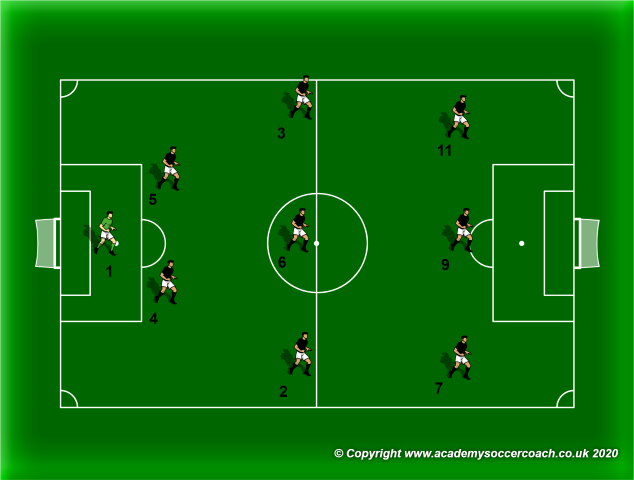
Progression to the 11v11 game: 1-4-3-3 by adding the two full backs to the defensive line.
Pros:
It is very strong in attack with both midfield and forward lines bearing three players.
There is width in attack with plenty of options on the flanks with the possibility of creating overloads.
With three players at the front and another three in midfield it allows the team to press high.
Plenty of options in the final stages of the build-up due to the number of passing lanes formed.
Cons:
There is lack of coverage at the back with only two central defenders.
The central midfielder can easily be outnumbered if no support from the lateral midfielders is provided in the defensive phase.
The striker might become outnumbered especially when playing against two central defenders.
The required players’ characteristics.
The defensive line:
The two central defenders should be good at 1v1 defending and at least one of them be comfortable on the ball during the build-up phase. These two players should also dominate aerial duels. They should be proficient in the principles of defending and zonal marking while identifying how and when to remain compact to delay play or apply aggressive pressure to win the ball.
The midfield line:
The lateral midfielders (or wing backs) should have a high level of endurance to provide cover at the back, support the central midfielder and to create overloads in the attacking third with the outside forwards. The central midfielder should be able to read the game well, possess a high technical level and move intelligently to offer support in the build-up phase.
The forward line:
The outside forwards (7 and 11) should be confident at taking on defenders in 1v1 situations and also cut inside to create overloads centrally in the penalty area. The striker should be good at receiving the ball outside the penalty area while getting unmarked to turn and engage the defenders in direct duels. The striker should also be able to hold and lay the ball well to the outside forwards and midfielders inserting into attack.
Characteristics of the 1-2-3-3 system of play.
This system could be used by teams operating either a direct or a dominant style of play. The three players in the forward line together with a three player midfield encourages a high pressing game. The players operating in this system should be able to apply immediate pressure upon losing the ball.
Winning the ball as quickly as possible guarantees that pressure on the opponents inside their defensive third is maintained and the risk of a counter attack with a direct long vertical ball is minimised. Putting pressure continuously on the opposition’s defence will automatically reduce threats on the attacking team’s goal as the whole of the opposition team must drop deep in order to defend. To be able to accomplish this however, the team that employs such as system and style of play must have players who are offensive minded, bear a high level of technique, and also two central defenders who can play the ball from the back with great accuracy.
By Philip Cauchi


